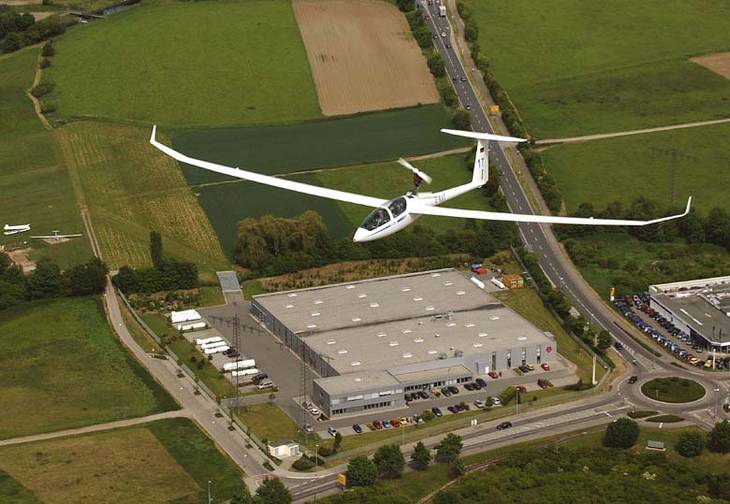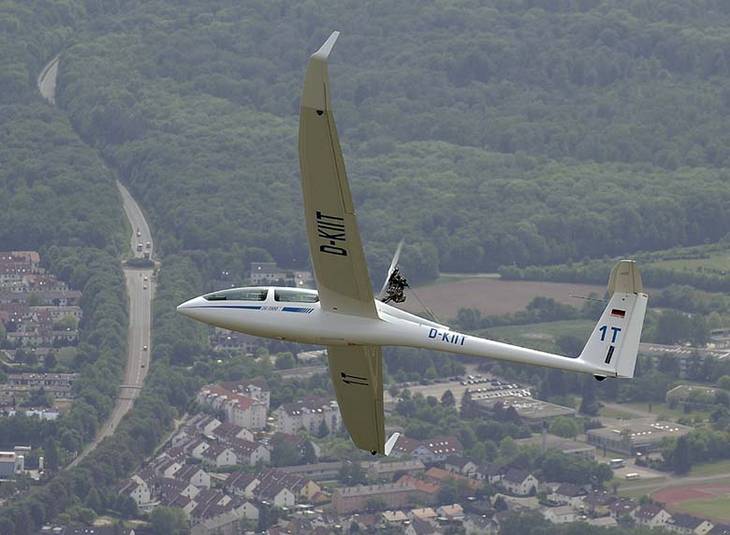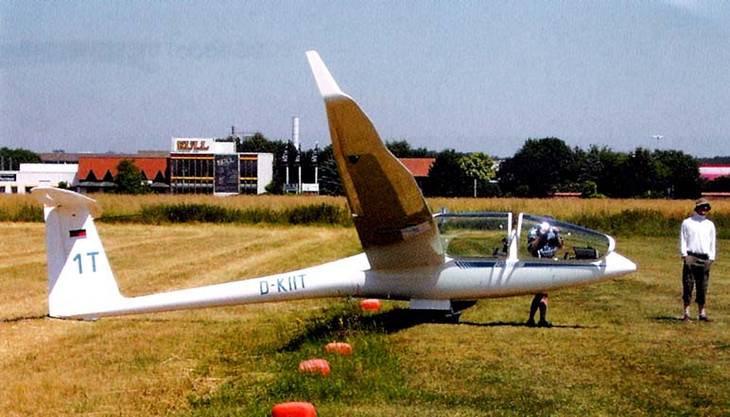A report by Jochen Ewald for the magazine Segelfliegen
When developing the turbo for the DG-1000, DG used their extensive experience in the design and construction of self-launching motor gliders.
As a result, the new aircraft contains several features youd be looking for in vain elsewhere.
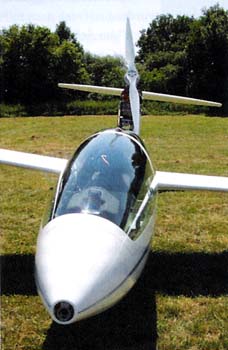 The DG-1000S, in production since 2001, has already proved its popularity as the most powerful universal two-seater in the 20-metre class worldwide, and the one with the longest lead times on the German market. The DG-1000T is also the first glider of DGs own range which has been equipped with a self-sustainer, usually called turbo. More and more pilots and clubs wish they had such a glider with an inbuilt thermal as it not only reduces the risk of landing out , but also increases the availability of the glider on cross-country days, avoids retrieve trips and thereby ensures a much more economic use of the aircraft. As a result of this trend, an increasing number of high-performance single seaters are already being supplied with an engine.
The DG-1000S, in production since 2001, has already proved its popularity as the most powerful universal two-seater in the 20-metre class worldwide, and the one with the longest lead times on the German market. The DG-1000T is also the first glider of DGs own range which has been equipped with a self-sustainer, usually called turbo. More and more pilots and clubs wish they had such a glider with an inbuilt thermal as it not only reduces the risk of landing out , but also increases the availability of the glider on cross-country days, avoids retrieve trips and thereby ensures a much more economic use of the aircraft. As a result of this trend, an increasing number of high-performance single seaters are already being supplied with an engine.
Like nearly all DG-1000s, the DG-1000T prototype is equipped with a high retractable undercarriage designed for optimum aerodynamics and suspension. It does take a certain amount of lifting strength to remove the tail dolly before the launch. Together with designer Wilhelm Dirks, I make myself comfortable in the cockpit. Climbing in is easy despite the fuselage being quite high at the front, as the canopy opens to the right, and the instrument cowl is free-standing: you sit on the side of the glider, swing round, place your legs either side of the cowl and lower yourself into the seat. Both seats can be adjusted comfortably for tall and for short pilots, and everything is easy to handle. The Colani control stick knob, which was launched at the trade fair in Friedrichshafen, is also installed a little too high, unfortunately. That makes it difficult to fully exploit the advantages of the two gripping positions (at the top, with the entire hand, for situations where strength is needed, and at the bottom, with just thumb and index finger, with the arm resting on the thigh). New in the front instrument panel is the DEI-NT engine control unit, which had already been incorporated in the DG self-launching gliders, and which has now been re-programmed to suit the new role of the DG-1000T as a single seater.
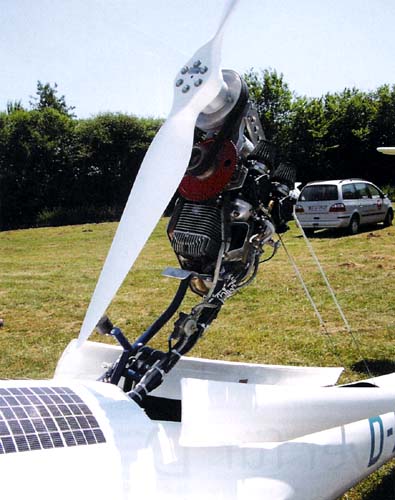 The ballast box in the rudder unit, acting to counterbalance the weight of the rear occupant, is full. This is indicated in the cockpit: a light flashes 10 times before it pauses, meaning that 4 large and 2 small trim weights are in use, counterbalancing an overall weight of 100kg in the rear seat. A look into the manual reveals that, with 85kg in the front and 80kg in the rear seat, we have an aft C of G. Its a hot summers day in Bruchsal with over 30 degrees C, the airfield is not that long, and the only tug available is a Super Dimona TTC . A little on the weak side for a normal aerotow with such a heavy two-seater!
The ballast box in the rudder unit, acting to counterbalance the weight of the rear occupant, is full. This is indicated in the cockpit: a light flashes 10 times before it pauses, meaning that 4 large and 2 small trim weights are in use, counterbalancing an overall weight of 100kg in the rear seat. A look into the manual reveals that, with 85kg in the front and 80kg in the rear seat, we have an aft C of G. Its a hot summers day in Bruchsal with over 30 degrees C, the airfield is not that long, and the only tug available is a Super Dimona TTC . A little on the weak side for a normal aerotow with such a heavy two-seater!
This gives us the opportunity to try out one of the new features built into the DG-1000T. Its engine comprises an electric starter and a throttle lever so that it can be started before the launch and can therefore assist in the tow. Starting it is simple: main switch on, ignition on, and the turbo is deployed.
The starter button can be pushed even while the turbo is still being deployed it isnt activated until it has reached its operating position.
The DEI takes care of all engine settings. You press the starter button briefly, and the engine starts to idle with a hum.
|
|
| Despite its relatively high fuselage, the DG-1000T is easy to get into. |
| Construction: Training and high performance two-seater in CRP/GRP, wings in 4 sections with an overall span of 20 m, retractable self-sustaining engine. Using the 18m winglets, and with an all-up weight of 630 max, also suitable for aerobatics. Wing assembly by means of a tongue and fork construction, secured with 2 main pins and 2 pins through the rear drag bar, automatic aileron and airbrake connectors via torsion links. Water ballast tanks in the wings for up to 160 litres, fuselage with high, sprung, retractable undercarriage and tail wheel (alternatively, nose-wheel gear with fixed or retractable main wheel can be supplied). Battery mounting, trim weight mounting and water ballast tank (6.5 l) in the tail fin, optional ballast box by the front seat. All tanks are filled through the outlets. Automatic elevator connection with locking mechanism on the side clearly visible. Retractable air-cooled 30 PS SOLO 2350 2-stroke auxiliary engine with a reduction ratio of 1:2.3, electric starter and DEI engine control in the front cockpit, optionally also in the rear (except for the throttle lever). 2-blade DG propeller with a 1.48 m diameter, fuselage tank, capacity 22.5 l, fuelling with a built-in pump via a quick connector hose |
At the same time as the Super Dimona, I open the throttle. The ailerons respond as soon as we start to roll, and the combination is accelerating nicely. Due to the high undercarriage, the angle of attack formed with the ground is such that the DG can lift off at minimum speed, at the same time as the tug. At a tow speed of 100kph, the engine is purring at maximum power output.
The extra 30hp are very effective: at the end of the airfield we are clearly higher than a conventional combination of a Dimona and a light single seater. This use of an engine does not only provide extra safety, it also saves expensive towing time because you can pull off earlier without having to worry about the amount of height you use up before the engine starts.
Deploying and retracting the undercarriage with the control lever on the left is effortless, and it has a positive lock. The view from the cockpit and the ventilation are superb. The spring trim allows optimum trimming at speeds of up to 190kph, whereby the trim indicator on the left-hand cockpit side has to be adjusted slightly against the spring resistance after it has been unlocked using the lever in front of the control stick.
The cable release knob is located a little higher than in the first DG-1000S prototype I flew, so that it is now also easily accessible for pilots with thicker thighs. After pulling off, the DG-1000T continues to climb at a rate of 1.3 m/sec. In level flight, with the small two-stroke engine running at its maximum continuous power of 6,500 rpm, the glider achieves a flying speed of 130kph. However, you hardly ever need that much speed, unless you have to run for home under a low cloud cover. Dolphining is always more sensible and economical.
Because there are always some vibrations when flying a motor glider with its engine deployed, inexperienced pilots sometimes find it difficult to notice the natural stall warning, a light buffeting. That is why the DG-1000T is now equipped with a newly developed stick shaker. This device takes the pressure measurements from two probes located at the front and under the nose of the fuselage and calculates the angle of attack, generating clearly perceptible vibrations as soon as the speed enters the critical range. This works really well with all configurations and, unlike audio warning signals, does not get on your nerves to such an extent that you want to switch it off straight away.
Turning off the engine at a flying speed of 90kph is simple: after a short cooling phase on tick-over, you turn off the ignition. The engine pylon automatically moves back a little, and due to the angled position the propeller quickly stops. Once stopped, the pylon tilts back a little further and the propeller stopper swings into place. Pressing the starter button causes the propeller to turn slowly forwards up to the stop, then the engine assembly retracts completely. The entire retracting process takes just 15 seconds, during which there are virtually no changes in load distribution.
Starting the engine in mid-flight, also at around 90kph, is just as easy and fast: ignition on, and the turbo is deployed. 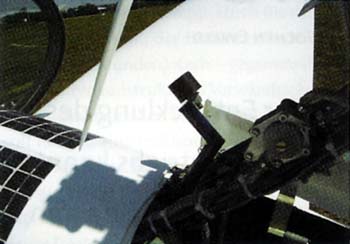 The starter button on the throttle lever can be pushed even while deploying the engine. As soon as the engine is deployed completely, it starts. This takes about 17 seconds altogether, and the height loss of 20 metres is markedly lower than with turbos that windmill-start their engine. One drawback of this system is the fact that one will need a very high speed to start the engine with insufficient battery voltage it is possible to reach the necessary starting revs by windmilling, but one must fly very fast and will loose much altitude.
The starter button on the throttle lever can be pushed even while deploying the engine. As soon as the engine is deployed completely, it starts. This takes about 17 seconds altogether, and the height loss of 20 metres is markedly lower than with turbos that windmill-start their engine. One drawback of this system is the fact that one will need a very high speed to start the engine with insufficient battery voltage it is possible to reach the necessary starting revs by windmilling, but one must fly very fast and will loose much altitude.
In flight, with the engine deployed and stationary, the sink rate of the DG-1000T increases to about 1.1 m/sec. The extended engine has no discernable effect on controls and flying characteristics.
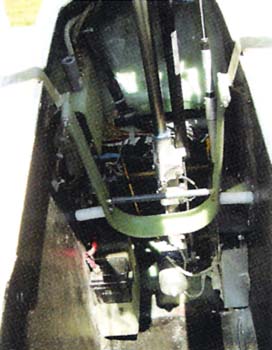 Just like its unpowered sister aircraft DG-1000S, the DG-1000T is a marvellous sight when soaring. The controls are easy to handle and can be trimmed harmonically to about 100kph. Thermalling at 85 to 95kph with 30 to 45 degrees of bank, using a little extra rudder, it climbs beautifully. And it definitely proves a match for the 18-metre single seaters we are thermalling with, a DG-808S and an LS8! At a speed of 105kph, I measure the DG-1000Ts roll rate to 45 degrees at a useful 4.7 seconds. Its stall characteristics are excellent, too. With 77kph on the ASI, the stick vibrator came into action. At 75kph, the controls became mushy, and at just below that speed we felt some buffeting, the first sign of airflow separation, before it wants to stall with a wing drop at 72kph. This is easily remedied by using the rudder and relaxing the back stick pressure a little. The aft C of G also makes it possible to spin the aircraft easily and safely an important point when using it as a trainer!
Just like its unpowered sister aircraft DG-1000S, the DG-1000T is a marvellous sight when soaring. The controls are easy to handle and can be trimmed harmonically to about 100kph. Thermalling at 85 to 95kph with 30 to 45 degrees of bank, using a little extra rudder, it climbs beautifully. And it definitely proves a match for the 18-metre single seaters we are thermalling with, a DG-808S and an LS8! At a speed of 105kph, I measure the DG-1000Ts roll rate to 45 degrees at a useful 4.7 seconds. Its stall characteristics are excellent, too. With 77kph on the ASI, the stick vibrator came into action. At 75kph, the controls became mushy, and at just below that speed we felt some buffeting, the first sign of airflow separation, before it wants to stall with a wing drop at 72kph. This is easily remedied by using the rudder and relaxing the back stick pressure a little. The aft C of G also makes it possible to spin the aircraft easily and safely an important point when using it as a trainer!
The large, effective Schemp-Hirth airbrakes increase the stall speed by approximately 5kph, and the trim speed increases by 15kph so that the aircraft does not have to be re-trimmed for landing.
Flying a base approach of 100kph, the effective airbrakes facilitate control of the angle of approach within a wide range. Sideslipping is very effective, too, and the light tendency to yaw very easily controlled with rudder. Fully held off, the DG-1000T touches down softly with both wheels at once, the superbly sprung main wheel smoothes out any bumps on the runway. Due to the high tail load, using the hydraulic wheel brake, which is linked with the airbrake lever, does not pose the risk of scratching the fuselage belly. On the other hand, changes in direction while slowly rolling to a stop is only possible by reducing the tail load during braking. The aileron remains responsive almost completely until the aircraft comes to a stop.
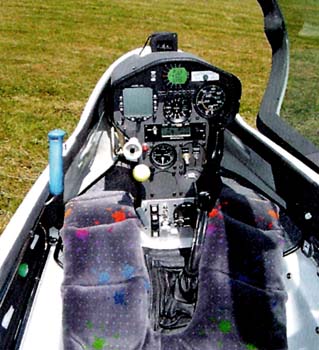 The DG-1000T is the first turbo introduced by DG. The engine control philosophy employed is a clear departure from the standard found in other self-sustaining gliders so far. Including a starter and a throttle lever certainly makes the design more complex and more expensive than the conventional auxiliary powerplant used to date. However, it also enabled a clear reduction in the height required to start the engine. And the use of the engine as a launch aid during the aerotow must surely prevent some critical and tight situations on airfields with a short runway, or where only relatively weak tugs are available.
The DG-1000T is the first turbo introduced by DG. The engine control philosophy employed is a clear departure from the standard found in other self-sustaining gliders so far. Including a starter and a throttle lever certainly makes the design more complex and more expensive than the conventional auxiliary powerplant used to date. However, it also enabled a clear reduction in the height required to start the engine. And the use of the engine as a launch aid during the aerotow must surely prevent some critical and tight situations on airfields with a short runway, or where only relatively weak tugs are available.
Demonstrating its qualities in many competitions, the DG-1000 has proved that it belongs among the top 20-metre two-seaters, while also being fully suitable for training purposes. A further point in its favour is the fact that DG, as the first manufacturer in Germany, have made the DG-1000 officially suitable to be flown with P1 in command occupying the rear seat, provided that the rear seat is also equipped with all the necessary controls and instruments. This eliminates insurance problems which existed before. As a prerequisite, the pilot flying from the rear seat must have familiarised himself with flying from that position (ideally have completed a check flight with an experienced instructor and have this confirmed in his log book ), and, with two pilots in the aircraft, it has clearly been established before the launch who is in command (which should also be noted on the flying list)!
With the tip extensions for an 18 metre wing span, the aircraft is fully aerobatic, provided that the take-off weight is kept below 630kg. When flown solo that is not a problem. And when it is to be used as a two-seater, on aerobatic courses for instance, the turbo can be removed without too much of an effort.
This makes the DG-1000T a true, if not exactly cheap allrounder.
Jochen Ewald
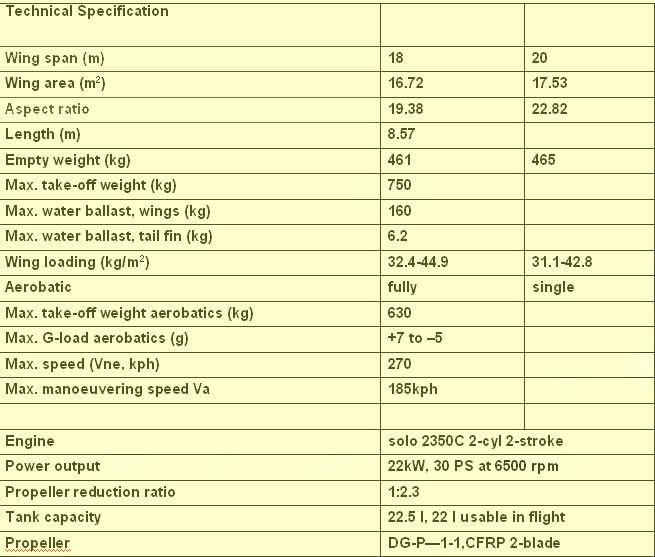
Turbo-assisted LaunchThe technique of turbo assistance during aerotow, demonstrated when test flying the DG-1000T at the DG site, seems sensible and practical, especially with heavy gliders. It did lead to some discussion amongst pilots, though, in particular the question: Is that actually permitted? A query directed at the LBA (the German Civil Aviation Authority) clarified the matter: Generally speaking, the use of the motor gliders auxiliary power during an aerotow is not permissible at the moment! The procedures to be adopted in case of engine failure during this launch method, employed by DG during the DG-1000T test flights, and any effect this might have on the safety of the launch, are yet to be explored and demonstrated. Basically, this is a two engine combination, being flown by two independent pilots, and any emergency procedures must be well coordinated. Following scenarios, for instance, are still to be investigated for their effect on launch safety: a) Tug engine failure at a stage where the launch can still safely be aborted: b) Glider engine failure at the same stage: c) Glider engine failure after this stage: d) Tug engine failure after lift-off: For those reasons, LBA approval of turbo-assisted launches is not possible with the amount of information currently available. However, the LBA always has an open ear for innovations and procedures which would facilitate improved launch procedures without affecting safety. Jochen Ewald |
Two comments from DG Flugzeugbau:
There already are LBA test specifications for which we have to provide proof of performance. If we are able to provide positive proof, there probably wont be any more obstacles to an approval of turbo-assisted aerotow.
Most points have been dealt with!Jochen Ewald is absolutely right in saying that it is difficult to start the engine without electric energy. However, that is also true for all other turbo drives, because you always need power to extend the turbo out of the fuselage. Provided you do have enough power left in the battery to do that, there is probably going to be enough left to make the propeller turn once past the dead centre and then it will continue to rotate on its own accord in the wind, and then the engine starts.
Otherwise it is a huge advantage to have the chance of testing the engine on the ground.
– friedel weber –
Translation: Karin Hulsemann
